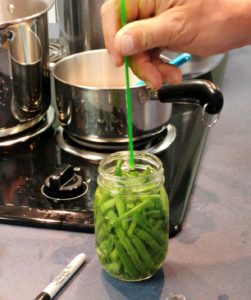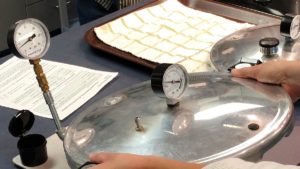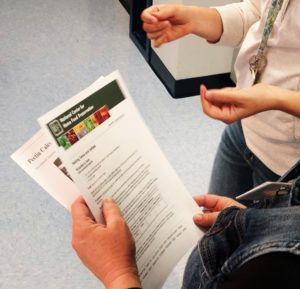
Finding Reliable Canning Advice
Local farmers’ markets are now showcasing fresh, summer produce which means that canning season is here! For many of us, putting up seasonal produce harkens back to watching Grandma in the kitchen with a steaming canner and rows of quart jars cooling on a towel. If you remember fondly Grandma’s pickles, Aunt Barbara’s stewed tomatoes or a neighbor’s salsa, you might be tempted to dig out their old recipe or head to the internet to find a similar recipe. Sometimes these recipes work well, but other times the results can be dangerous, or even deadly. Do you know enough about high elevation food preservation to tell a good canning recipe from a bad one?
Update your Canning Techniques
Unfortunately, many canning methods from Grandma’s day have been proven to be unsafe and should be avoided. The mistaken belief that a jar was canned properly if the lid sealed was prominent in canning books 30 years ago, and can still be found on the internet. We now know that the internal temperature of each jar must reach a critical temperature for a specific amount of time to kill harmful pathogens. Old-style recipes that instructed people to fill jars with hot ingredients and simply turn jars over to create a sealed lid, are not recommended. Inverting jars, heating jars in the oven and even “processing” canned items in a dishwasher will not get the contents of the jar to a safe temperature for long-term storage. And old techniques like sealing jars with paraffin wax have been discredited for years because of the molds and pathogens that can grow under the surface of the wax.
 Canning equipment has also improved in recent years. Newer pressure canners are larger and have safety features to improve the experience. When buying a pressure canner, whether at the store or your neighborhood garage sale, make sure it has the newer safety valve feature. Look to see if the canner will accommodate 4 quart jars, which assures that there will be enough space for hot steam to properly heat the jars. Contact your local CSU Extension office to annually test the dial gauge on your canner for accuracy.
Canning equipment has also improved in recent years. Newer pressure canners are larger and have safety features to improve the experience. When buying a pressure canner, whether at the store or your neighborhood garage sale, make sure it has the newer safety valve feature. Look to see if the canner will accommodate 4 quart jars, which assures that there will be enough space for hot steam to properly heat the jars. Contact your local CSU Extension office to annually test the dial gauge on your canner for accuracy.

Use Tested Recipes
Lastly, be cautious using canning recipes found on the internet or passed down through the family. Only use canning recipes from trusted sources that have been properly tested for safety and that provide adjustments needed for high altitude/elevation. Reliable sources include the National Center for Home Food Preservation, the Ball Blue Book, or CSU Extension, which have tested their recipes dozens of times to measure heat penetration and to test for microbes in different stages of the canning process. And fear not–there are plenty of well-tested recipes available that would be comparable to most old family favorites!
Call or visit your nearest CSU Extension office for assistance with home food preservation questions–our experienced Agents and Master Food Safety Advisors are available to help make home food preservation a safe and enjoyable endeavor!


This page definitely has all of the information and facts I needed
about this subject and didn’t know who to ask.
Karen, Great advice!